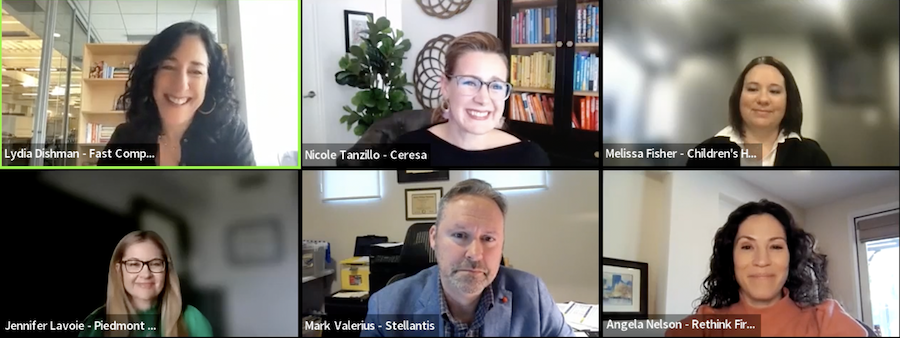Benefits That Benefit: What Workers Are Really Seeking


Mark Valerius is quick to recognize that, for people of his generation, the framework around benefits presents a unique challenge and a trove of opportunities. “I am a Generation X guy, born in 1965: we’re squeezed between parents, children in college, and still on payroll,” he tells journalist Lydia Dishman at the From Day One panel, titled “The Benefits That Employees Want to See Enhanced in 2023 and Beyond” during an April virtual conference.
“We become the parents, and the parents become the kids,” Valerius, who is the director of compensation and benefits for the automotive multinational Stellantis, continues. “And navigating veterans’ benefits, social security, medicare, life insurance, esp. when they need dedicated care…it’s a handful.”
Benefits have evolved since the start of the pandemic. According to a 2022 report by SHRM, healthcare still tops the list of important offerings, and while retirement benefits dipped, they’re now ranking high again, but, in all, benefits are now more embedded in the culture of the organization.
Moreover, 86% of employers said that mental health, burnout, and stress are still top priority, yet there is a widespread lack (nearly half of the respondents) of a formal strategy. This is a time of great opportunity, with COVID-accelerated initiatives such as remote work, DEI and wellness now straddling the line between benefits and structural components.
How Can You Bring Your Best Self to Work?
Nicole Tanzillo is the COO and founder of the ed-tech company Ceresa, where she finds herself reflecting both on benefits for her own employees and o the creative-leadership and development tools to provide to the early and underdeveloped talent that constitutes Ceresa’s user base. To her, remote work is a no-brainer. “Continuing to be a remote organization has been instrumental,” she says. “It has balanced my need to work my job and be there with my children and invest in my own health.”
Angela Nelson, the executive director of clinical services of the global behavioral and mental health platform RethinkCare reflects on a similar topic “Parenting benefits and work-life flexibility is really really key,” she says. “I can’t bring my best self to work if my company wasn’t supporting me as a mother.” Valerius, however, cautions against remote work, even among caregivers. “When you work from home you’re like a doctor or nurse with a pager,” he says.

How Do You Adapt?
Melissa Fisher, the director of compensation and benefits at Children’s Hospital Colorado, had to have her organization adapt pretty quickly. “I could work remotely but a caregiver is in the hospital, in the clinic. For us, it was easy and clean: we listened to that population,” she says. “We have a young workforce: where they are in life, it’s all about family planning, resiliency and behavioral health. We want to make sure we support family planning and student loans—how do we make sure we’re taking care of our caregivers so they can come into the office?”
Everyone has made interesting discoveries over the past several years, about how employees receive their benefits, wellbeing resources. “It has been challenging but also fun,” says Jennifer Lavoie, director of employment and well-being at Piedmont Health. What has been lovely to see was that, at the same time COVID hit, we brought on a DEI division in the healthcare system. I walked right up to my director and said there’s no employee wellbeing without DEI."
How Do You Foster Connection?
Valerius’s hesitation with remote work does not translate into a rigid approach “The approach is more of a hybrid, see where it goes, but I am concerned for the human element,” he explains “We see remote work can be productive. Sure, we can have videos, but quite frankly, we’ve been having meetings at the office and A LOT of people are enjoying them. You can really get things done quicker, too. Get a big whiteboard!”
At Piedmont Health, connection is independent from in-person work. “There are moments where we come together, but we’ve gone fully remote in some corporate capacity. We have employees across the country and we have to make sure they feel connected,” explains Lavoie.
“From where I sit, over the past several years we really wanted to pull back the veil and look at how each of our pillars are receiving and accessing care. We’re doing it with our clinical group and we’re putting execs in that group as well” Piedmont’s remote workers can take advantage of 1:1 and group virtual offerings with them. “We have various means to do this. it can be as easy and simple: it’s been interesting to pull back that veil,” she says.
How Do Leadership and Coaching Factor In?
One thing that is important when it comes to inclusion and benefits is looking at the full range: the majority of programs show that they are primarily focused on in-office knowledge workers vs hourly underrepresented groups.
“Another piece is proactive support: make sure they’re making space. We’re rolling out a brand-new program focused on early development, the executive organization was super bought in,” says Tanzillo. “We got feedback that the participants’ managers were NOT bought in. That was a real wakeup call: make sure we’re educating our frontline folks”
With all the money paid for access to great vendors, and great benefits, in fact, Tanzillo reports that participants did not know said benefits existed. “I think it’s important for underrepresented groups, for their manager to say hey, do you know that this is available? Knowledge and understanding are important in terms of inclusion.”
Angelica Frey is a writer and a translator based in Boston and Milan.
The From Day One Newsletter is a monthly roundup of articles, features, and editorials on innovative ways for companies to forge stronger relationships with their employees, customers, and communities.